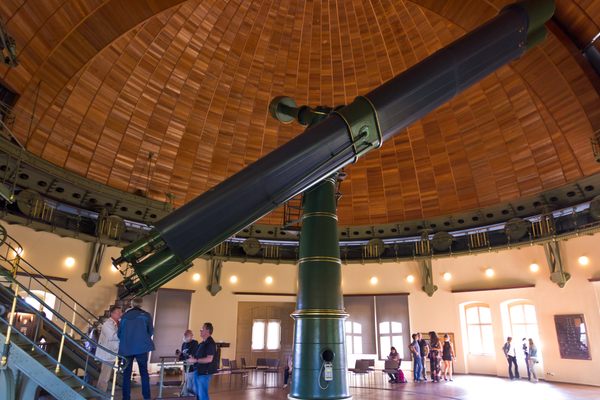McMath-Pierce Solar Telescope
The biggest solar telescope in the world helps reveal the secrets of our sun.
The McMath-Pierce Solar Telescope, atop Kitt Peak in Arizona, is the world’s largest instrument dedicated to studying the Sun. Designed by Bruce Graham of the prolific Skidmore, Owings, and Merrill architectural firm, the telescope commands an awe-inspiring view with its distinctive 110-foot-tall tower and 200-foot-long diagonal shaft.
Completed in 1962, the building’s main instrument is a heliostat, which tracks the Sun through the sky and focuses its light down through the diagonal shaft. This shaft continues about 50 vertical meters underground to a 1.6-meter primary mirror, forming the largest unobstructed aperture of any optical telescope system. From here, the light travels back up a portion of the shaft to a flat mirror, which then reflects an 85-centimeter wide image of the Sun downward to a subterranean laboratory.
In addition to being the largest solar telescope in the world, the McMath-Pierce is also unique because it is sensitive enough to observe bright stars at night. The telescope also boasts a low-cost (which translates from astronomical terms to less than $25,000) adaptive optics system. This setup utilizes a rapidly deformable mirror to correct for distortions introduced by the turbulent atmosphere. Using sensors to measure the degree of image distortion, the adaptive optics system adjusts the mirror’s shape accordingly and thus turns a blurry image into a clear one.
One major area of study at the observatory is the structure of sunspots, which are relatively cold, dark spots on the Sun’s surface created by intense magnetic activity. Some of the more important discoveries made at McMath-Pierce, however, include the detection of water vapor in the Sun, the measurement of kilogauss magnetic fields (thousands of times stronger than the Earth’s) outside of sunspots, and the detection of a natural maser (like a laser, but with microwaves instead of visible light) in the Martian atmosphere.
Update as of January 2022: “We are currently not hosting public visitors to the summit or base facilities. With the continuously evolving nature of the pandemic, we currently do not have a reopening date. We will update this page when a reopening date is available. The timeline may be different for each site.”.
Know Before You Go
Kitt Peak is 56 miles southwest of Tucson via State Route 86 on the Tohono O'Odham Reservation. Allow 90 minutes of drive time from Tucson. Take I-10 to I-19 South. Less than 1 mile is Ajo Way/Hwy 86 (Exit 99). Take this exit West (right). Proceed past Ryan Airfield and Three Points. Continue until Junction 386 (Kitt Peak turnoff). Turn left onto 386. The Kitt Peak Visitor Center is located at the summit (12 miles).






















Follow us on Twitter to get the latest on the world's hidden wonders.
Like us on Facebook to get the latest on the world's hidden wonders.
Follow us on Twitter Like us on Facebook